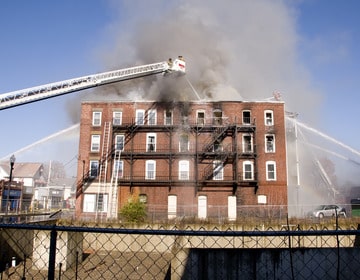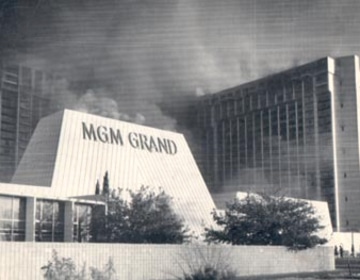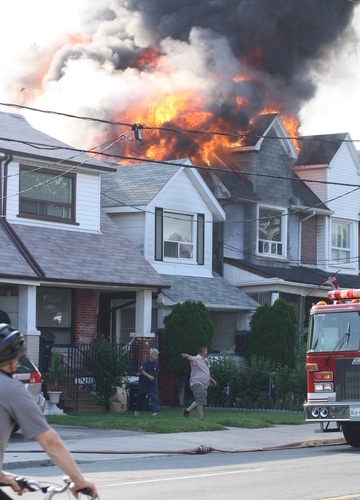Residential and Commercial Fires

Fire incidents are more common in Las Vegas and Nevada now that older construction and apartment buildings are aging. Fire Code has changed dramatically in the past 40 years. Building codes have also been revised to include the more modern approaches to building fire safety. Such local changes included major modifications in the respective dwellings from residential homes to our ginormous hotels and buildings. Each of these are addressed in the following sections.
Apartment Fires
Las Vegas boomed in the 1970 and 80’s with many of the early apartment complexes taking shape—many boomed on the East side of Las Vegas as most of the West was yet to be developed. Over the years, these buildings have changed ownership with little done in terms of enhancements to life safety issues. Older smoke alarms, older electrical equipment and wiring are simply worn out and not effective in providing a safe and useful service. Rats and mice eat at wiring exposing the copper lines to serious exposure ripe for causing sparks and electrical fires. Fire barriers are non-existent in common walls increasing the likelihood of fire spread, and basic smoke and fire suppression equipment. Sprinklers suppression systems are proven life savers, and older apartments do have such systems. Recessed can lighting equipment is now required to have fire rated boxes when installed in or around garages. Numerous safety regulations are now in place that are missing in most of the Las Vegas apartment complexes.
Hotel Fires

The MGM fires in Las Vegas in 1980 killed 85 people where most died from intoxication of fumes. The fire broke out in ground floor deli caused by and electrical ground fault inside a wall socket. In 1981 the Hilton fire killed 5; subsequently, all Nevada Hotels were required to have fire sprinklers, smoke detectors in rooms, and exit maps. After 9/11, when the twin towers toppled in New York, Fire code was dramatically revamped primarily for the actual structural improvements, but also wide sweeping changes for exits, stairways, and signage. Engineers and the National Institute of Standards and Technology (NIST) made recommendations that were adopted by the IBC (international building code) and IFC (international fire code.) While nothing may guarantee the absolute prevention risk of fire by terrorism, accident/negligence, arson, or faulty equipment, regulations to increase fire survival and building collapse have been incorporated since 2008 when regulations were implemented. NFPA, the National Fire Protection Agency, Large buildings have new codes to apply:
- 3rd exit stairway for buildings exceeding 420’ high.
- Stairway exit widths be extended by 50%.
- Elevators encouraged in evacuation in tall buildings.
- Fireproofing the exit shafts with stronger, harder materials.
- Stairway enclosures should not be less than 30’ apart.
- Addition of Fire service Access elevator on hotels and buildings more than 120’.
- Lobby sizes increased > 150 sq. ft.
- Access Elevators not allowed to store goods.
- Not less than 2 water supply risers for sprinkler zones in high buildings for better reliability.
- Minimum structural integrity for bearing walls. 11.) “Structural frame” fire resistance ratings for internal building components like beams and trusses to match the strength and resistance of columns.
- Including bracing equipment to vertical stability in all areas.
- Increasing bod strength of fireproofing x 3.
- Fireproofing install requirements: mirror mfg. instructions, clean application for adhesion, testing of adhesion, devoid of cracks.
- Thickness and application testing of fireproofing.
- Exit path markings illuminated for 75’+ buildings.
- Exit doors, signs, floors for 75’+ buildings.
- Enlarging the fire command center to 200 sq. ft. for buildings 75’+.
- Approved radio coverage for emergency response communications.
- Hardwired to non-hardwired systems.
Residential Fires

Big changes came in 2006 when homes over 4,000 sq. feet were required to have fire sprinkler systems added; subsequently, in 2010 Henderson required all homes to have sprinklers. In 2018, it became required for all city of Las Vegas residences to have sprinklers. As of 2019, Carbon monoxide detectors are not required in Nevada residences. 27 states require them, and 11 others have it required by adoption of building code. Nevada is slow to adopt. Residential fires are caused by everything from dwellers’ candles, cigarettes, stove fires, Christmas tree ignition, electrical equipment, to faulty wiring. Safety prevention and fire suppression items include smoke alarms, wireless carbon monoxide, verbal microphoned and speaker smoke alarms, digital smoke imaging, fire suppressant systems with water, mist and fire retardant. Residential fires cause major devastation and displace occupants often causing respiratory injuries and sadly, death. Can these be prevented? The answer is: most of the time, and more frequently than is currently occurring. Updating fixtures to fire compliant code is critical. Using outdated inefficient Air handlers and HVAC systems are prone to excess heat and fire. Placing the handler on the roof is not convenient for service and must be directly wired through the attic of most homes. Given the older homes use tar shingles and not clay tile, the fire resistance is not as great. Newer homes have much better fire code compliance from the electrical systems to the appliances, and materials used to construct homes. Modern technology will give better advance notice and warning, and suppressive techniques will make fire extinguishing much better in the early stages. This uptick in residential fires is not just in Nevada but also nationally; according to the National Fire Protection Association:
“Home fires. U.S. fire departments respond to an average of one home fire every 88 seconds. Between 2012 and 2016, U.S. fire departments responded to an average of 355,400 home structure fires per year. These fires caused 11,670 civilian injuries, 2,560 civilian deaths, and $6.5 billion in direct damage.”
Homeowner’s insurance protection is normally required on mortgaged residences to provide coverage in the event of loss. The extension of that coverage beyond a fire hazard policy protecting the structure to cover injury losses varies. Such liability coverage can range from $25,000 liability to umbrella policies in the millions. The advent of Airbnb and short-term lessors creates a potential coverage issue for fire claims when the house is used in a commercial fashion, but the internet company will often carry in upwards of $2M in coverage for losses.
Commercial Fires
Warehouse, industrial buildings, and commercial center fires including restaurants comprise the bulk of property damage claims. The bulk of fire issues are caused by kitchen and cooking fires. Fire extinguishers and fire alarms prevent the spread of such incidents and are usually witnessed such that a response can be fashioned to exterminate the fire. Older commercial centers are not outfitted with Sprinkler systems and at risk of larger catastrophic damage when the fire is not contained. Commercial fires that occur in high rises or low rise 2-3 story buildings run higher risks given the upward spread of the fire.
Legal Ordinances
In 2018 Clark County improved their safety code with the adoption of the most recent fire safety laws. Everything from thickness and water requirements of the automatic sprinkler pipeage, smoke removal systems, graphic displays, LED illumination, heliports, testing, $5M policy for financial responsibility for fireworks permits, $1M policy for fireworks stands (safe fireworks), standards for flame effects before an audience, fire hydrant requirements (minimum spacing and distances colors, yellow and red), motorized entrance gates, this is covered in the NFPA. Getting older buildings to adopt such ordinances is difficult given the “grand father” clauses that protect existing structures from bringing buildings up to current code. This is often and economic decision. Unlike the ADA federal rules, which required older businesses to actually retrofit older building even if at their expense, the fire code has surprisingly not required such effort.
Legal Principles in a Fire Case
Fire cases require fire experts. Experts who understand origins of fire, electrical engineering, and combustion sources. Similar to automobile and aviation accidents, attorneys initially rely on the authorities who reach conclusions based upon available information and evidence. Often the scene is not available for investigation after a fire has occurred and the site is demolished. In Nevada, fire cases are initiated with a Negligence lawsuit, wrongful death under NRS 41.085, and recklessness if applicable.
Negligence Per Se. When a breach of law, rule or city ordinance occurs, a plaintiff can apply the law violation as a presumption of negligence against a defendant. In the context of a fire case, if laws have been broken such as failures to install and maintain smoke alarms, a building code, a plaintiff can assert that breach of the building code as Negligence per se shifting the liability presumption to the Defendant landlord. In, Barnes v. Delta Lines, 99 Nev. 688, 690 (1983) the Nevada Supreme court reiterated it is error not give a jury instruction when a, “Defendant violates a statute which was designed to protect a class of person to which the plaintiff belongs, and thereby proximately causes injury to the plaintiff, such a violation constitutes negligence per se, unless the defendant can show that the violation was excused. (See (Gordan v Hurtado, 96 Nev. 375, 609 P.2d 327 (1980); “ Thus, when a violation of a building code that had been adopted by the Clark County building department or other governmental agency, violation of that code, the jury may take notice, as a matter of law, that the violation was negligent without further evidence. The pattern jury instruction states, “An unexcused violation of the law[s] just read to you constitutes negligence as a matter of law. If you find that a party, without excuse or justification, violated a law just read to you, it is your duty to find such violation to be negligence; and you should then consider the issue of whether that negligence was a [proximate] [legal] cause of injury or damage to the plaintiff. The burden of proof is upon the person who violated the law to show by a preponderance of the evidence that such violation was excusable or justifiable. A violation of law is excusable or justifiable only if you find that the person who violated the law did what might reasonably be expected of a person of ordinary prudence, acting under similar circumstances, who desired to comply with the law. NJI 4.13. Thus, the Negligence per se doctrine of liability is an important principle in proving fire cases.
In fire cases, practitioners may want to rely on theories of law that help prove a case when the cause may be a mystery as to exactly who did it, but might be generally known—common examples include aviation failures and medical malpractice cases. Unfortunately, it is not a viable legal theory in this context. Res ipsa Loquitur: “The thing speaks for itself.” In Nevada, the elements for a claim of the tort of res ipsa loquitur:
- “The events are is the kind of events which ordinarily do not occur in the absence of someone’s negligence;
- Were caused by an agency or instrumentality in the exclusive control of the Defendant, over which the defendant had the exclusive right of control, originally, and which was not mishandled or otherwise changed after defendant relinquished control;
- Were not due to any voluntary action or contribution on the part of the plaintiff which was the responsible cause of his injury; and
- Able to prove Causation and damages.” NJI 4.18.
“Under the traditional res ipsa loquitur doctrine, the presumption of negligence only arises after the plaintiff has established that the event in question is one that ordinarily does not occur in the absence of negligence. Restatement (Second) of Torts § 328D cmt. c (1965).” As cited in Johnson v. Egtedar Johnson v. Egtedar, 112 Nev. 428, 915 P.2d 271 (1996). Unfortunately, Res ipsa loquitur is not an available for fire cases because in fire cases other causes may be to blame other than the landlord’s negligence. It would take a very specific set of facts in able to use Res ipsa in a fire case setting. The Supreme Court of Nevada stated, “Cases must occasionally happen where the person really responsible for a personal injury cannot be identified or pointed out by proof, as in this case; and then it is far better and more consistent with reason and law that the injury should go without redress, than that innocent persons should be held responsible, upon *827 some strained construction of the law developed for the occasion. Clearly, the doctrine has no application in this case, where there is lacking even a scintilla of evidence indicating which respondent had control of the cigarette that started the fire. FIREMAN’S FUND AMERICAN INSURANCE COMPANIES, Appellant, v. Andrew J. KNOBBE et al., Respondents., 93 Nev. 201 (1977).”
The Doctrine of Res Ipsa Loquitor may be applicable to certain cases as once certain causes are ruled out, inferences on circumstantial evidence become available to prove res ipsa. (See Seeley v. Combs, 65 Cal 2d 127, 1966). Fires do not normally occur unless there is a heat and/or ignition source. When no Act of God, nor other intentional act presented including the strong possibility that human factors will also be ruled out, negligent maintenance can be a circumstantial cause. With building, condos, or apartments, residents do not control or maintain the exterior of the buildings and this is the exclusive control of the landlord, and typically nothing the Plaintiffs or victims contributed to the fire. Thus, under a res ipsa theory, Negligence may be proven with a rebuttable presumption of liability.
Rescue Doctrine: Liability for those help
Under Nevada’s rescue doctrine, those who assist, rescue or help victims of a fire or other emergency may also recover. See Turpel v. Sayles 101 Nev. 345 (1985). “Where a defendant’s negligent act, of commission or omission, has created a condition or situation which involved urgent and imminent peril and danger, to life or property, of himself or of others, those acts of negligence are also negligence in relationship to all others who, in the exercise of ordinary care for their own safety under the circumstances, short of rashness and recklessness, may attempt, successfully or otherwise, to rescue such endangered life or property, by any means reasonably appropriate to the purpose…” Id. The Nevada Supreme Court (quoting New Hampshire law) quoted, “Henceforth, landlords as other persons must exercise reasonable care not to subject others to an unreasonable risk of harm. “A landlord must act as a reasonable person under all of the circumstances including the likelihood of injury to others, the probable seriousness of such injuries, and the burden of reducing or avoiding the risk. We think this basic principle of responsibility for landlords as for others `best expresses the principles of justice and reasonableness upon which our law of torts is founded.’ Id. Taken collectively, those who rescue when negligence is established can make a damages claim and it is recognized under Nevada law.
Evidence Retention
Fire destroys not only the structure, but may destroy evidence of the cause. When items that could be the cause of the fire, and are not completely destroyed, it is important the building owner or operator preserve such evidence. Metal objects that do not burn may give valuable clues to experts as what may have happened in a fire. Did a spark cause the fire? Was an electrical arch marking evidenced somewhere? Did a motor potentially cause the fire from overheating? Was a battery or ignition source a piece of thrown out evidence? Such issues are illustrated in the Nevada case law Bass-Davis v Davis, 122 Nev. 442 (2006). When a piece or set of evidence is lost, destroyed or not preserved, a jury instruction will be given that implies that an adverse inference shall be assumed by the jury that if the evidence was maintained, such evidence would be adverse to Defendant’s position (assuming it was the Defendant who tossed the evidence). In Bass, the Nevada Supreme Court reasoned and clarified exiting law from Wet-n-Wild precedent (see Reingold v Wet-n-Wild, 113 Nev. 967 (1997) that whether the evidence was intentionally destroyed or willfully suppressed makes a difference in whether the instruction shall be given. “Where relevant evidence which would properly be part of this litigation is within the control of defendants whose interest it would naturally be to produce it, and they fail to do so without a satisfactory explanation, the jury may draw an inference that such evidence would have been unfavorable to the defendants.” NRS codifies this in NRS 47.250 (3) “That evidence willfully suppressed would be adverse if produced.”
Under Federal law as well, “Litigants owe an uncompromising duty to preserve evidence that they know or reasonably should know will be potentially relevant to a pending or reasonably foreseeable lawsuit.” Leon v. IDX Sys. Corp., 464 F.3d 951, 959 (9th Cir. 2006).
Fire Cause Analysis
Determining the fire cause or likely cause is important in proving a fire case. Under Nevada law, a Plaintiff’s burden of proof is simply a preponderance of evidence or a “more likely than not standard.” With that in mind, it must be proven with 51% certainty that the fire cause was in fact what the plaintiff alleges. Fire investigators will provide a report with the basic information, and a more detailed report upon final investigation. Even if the cause is “undetermined” the report may rule out a variety of causes such as arson, human cause, or other causes that will help attorneys limit the focus of what could be the cause. Ignition sources will rule much of this information out. Were persons even near the ignition cite when it started? Was a flammable liquid used? Where did the fire begin and was that witnessed? What part of the building burned? How old was the structure? Did the area burned contain electrical components or electrical wiring? Did weather play a role? All of these questions will be used by experts to determine causes and rule out causes, and focus in on more likely causes. Given that fire scenes can be destroyed or leveled for safety reasons it is important that experts and fire authorities preserve scene evidence, take photos of evidence and investigate fully prior to demolition.
Joseph L. Benson II, Esq., handles fire litigation cases, fire wrongful death, hotel injuries, smoke inhalation cases, and is experienced in civil litigation with over 25 years of experience. Mr. Benson was recently interviewed by ABC Channel 13 regarding a wrongful death suit filed by Benson & Bingham Accident Injury Lawyers, LLC on behalf of the family that recently caused the tragic death of their daughter in the Solaire Apartments complex fire in Las Vegas. If you or a loved one has been injured due to a residential or commercial fire, contact our Las Vegas personal injury lawyers for a free consultation today.
Free Consultation

